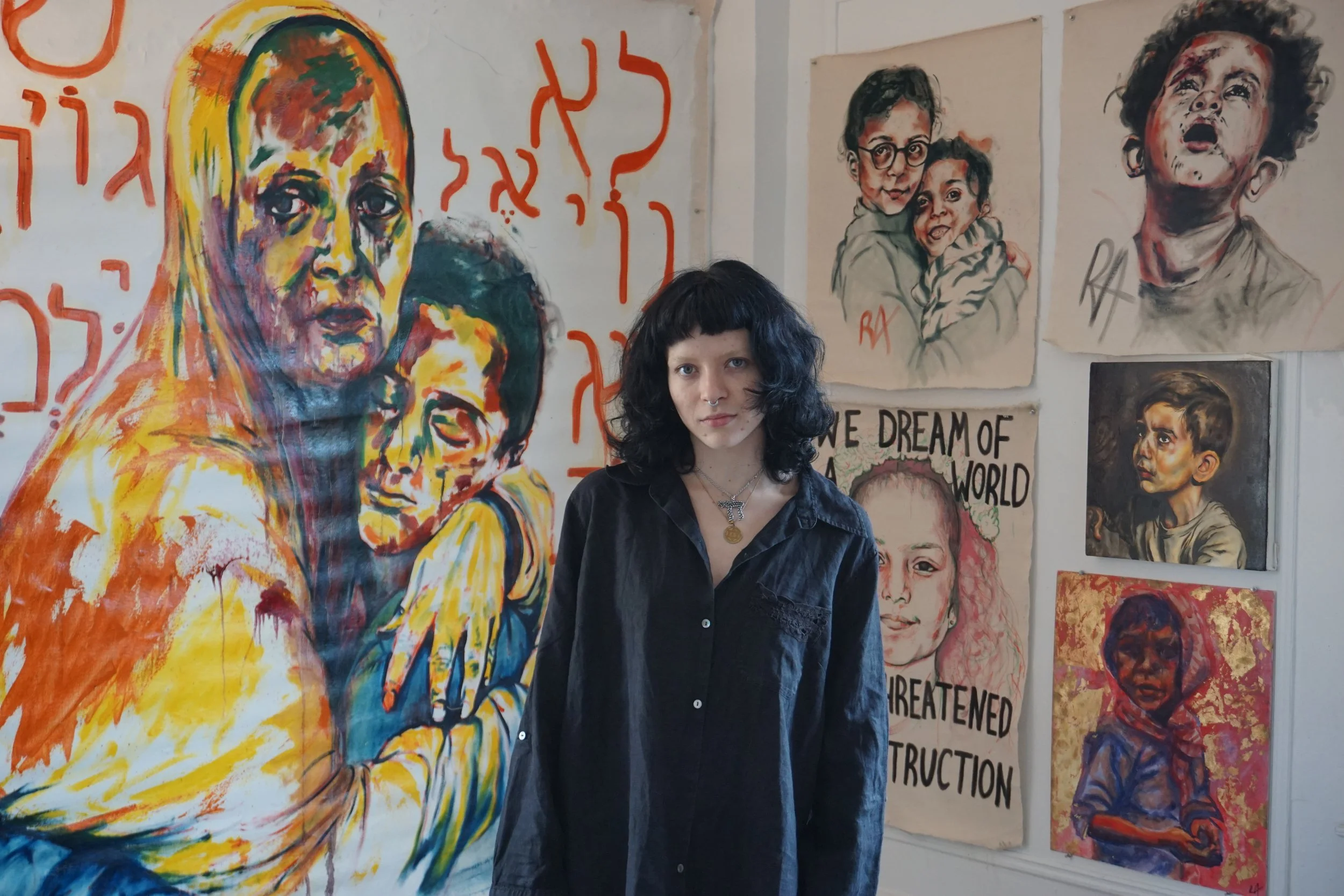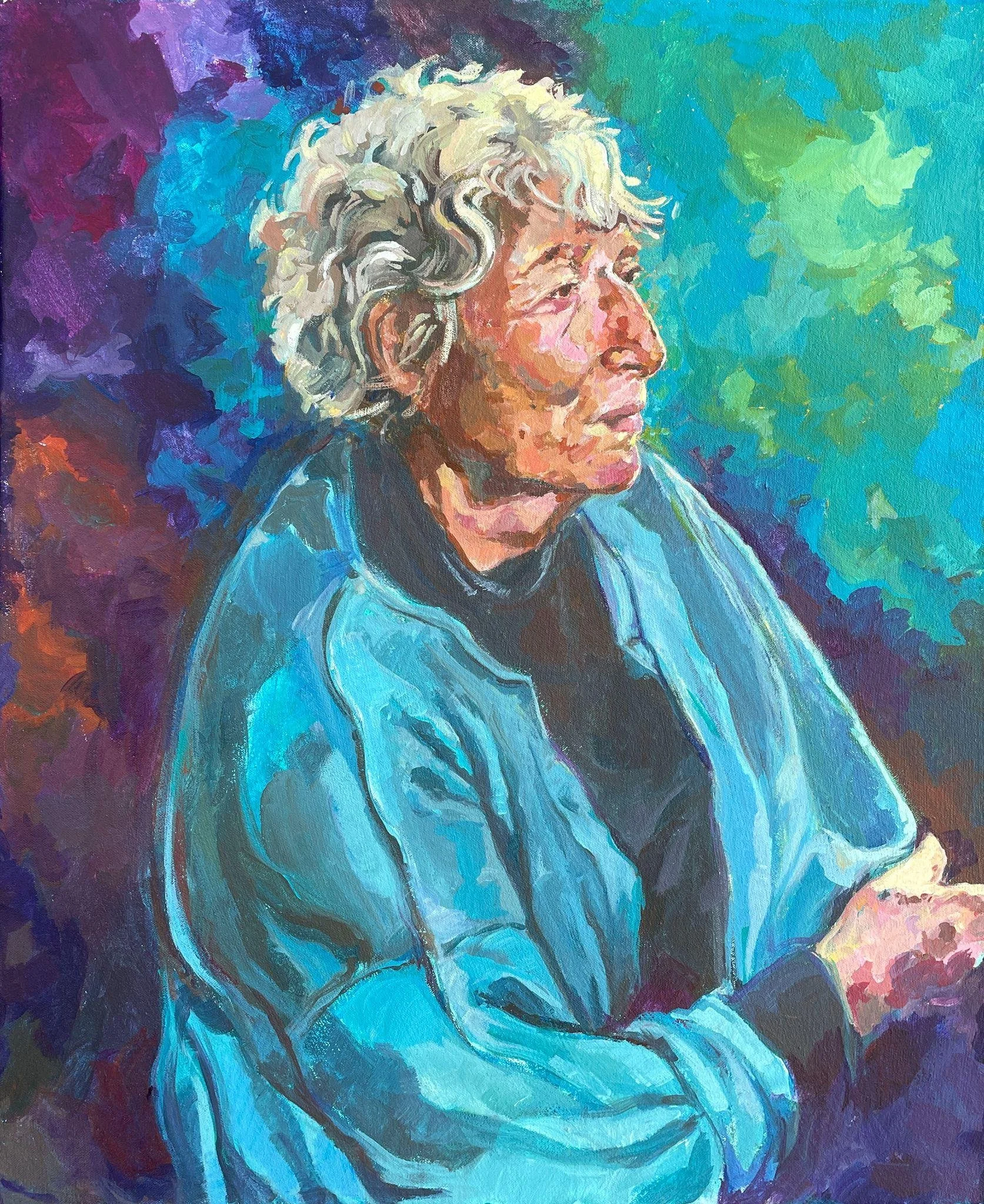Feature by Eve Rosenblum
Photos by Kendall Bartel
Kathleen Halley-Segal CC’ 28 is majoring in Art History and Visual Arts. She paints mostly in acrylic and watercolor. Her work was featured at the Bronx Borough Art Festival, the Met, and the YoungArts Week Exhibition and focuses mostly on topics of gender norms, adolescence, and intergenerational connection.
Thanksgiving at my Grandma’s house was an elaborate affair: 20 cousins, 4 uncles, 3 aunts, and 2 or so turkeys. A hodgepodge of tables pushed together piled high with an assortment of dishes sustained the conversation from afternoon into the evening. Kathleen Halley-Segal observes that the labor required for events like this one tends to fall on women. For them, the time-staking preparations are not necessarily a choice. Rather, fulfilling gendered expectations requires it of them.
Both the hardship and the strength granted by this subjection are main themes in Kathleen’s art work. Her grandmothers and mother feature often. The settings are quotidian. One painting shows Kathleen’s mother breastfeeding. A suburban family home stands out in a melange of pink, blue, and green. Her mother’s lips are parted as though mid speech. In one hand, she supports her daughter. The other is placed casually behind her.
There’s a radical quality to this painting. In contemporary society, images of breastfeeding remain taboo. At the same time, women with children are frequently isolated from the identity of caretaker. Kathleen’s portrait both embodies this experience, and disrupts it. The woman in the painting is visibly interested in things besides the child. She challenges traditional depictions of mother and child.
A Mother Feeds Her Child
The women in Kathleen’s life also produced her interest in art. In my conversation with her, she described visiting her paternal grandmother’s home.
“She loved art. She’d compiled clippings over the course of her life that we would look through together.”
Her grandmother inspired the younger Kathleen as she puts it, “to capture the intricacies of the small details in the world.”
She Looks Forward, a painting of her Grandmother, seems to do just that. Every fold is visible in her sweater. Her hair is silver, but also black, and gray. She gazes away from the viewer, in reflection. She is both the older version of herself and all the years before. They all exist at once.
She Looks Forward
In high school Kathleen began a formal training at the Arts Student League on 59th Street. Classes helped to develop her technical abilities and other students offered a cohort of artistic peers.
Many of those peers are in art school now. Kathleen chose to study Art History at Columbia. She didn’t think studying art full time would be a good fit.
“I think that would not only be limiting in my life, but also limiting in my own artistic practice,” she says. “I think making art, or doing anything creative is about constantly getting inspiration from many different sources.”
One source of inspiration has been the City itself. Growing up in New York, Kathleen was tasked with navigating the subway from an early age. She noticed a sweetness and a holiness of people through these experiences, qualities not often noted in descriptions of New Yorkers. In her painting Sleeping on the D Train, a pair of teenage girls, heading to or from school, rest on each other. The window of the subway car is blue, as though looking out over the ocean or the sky.
Sleeping On the D Train
Her scenes of the city are reminiscent of artists Jordan Casteel and Alice Neel. Kathleen says they provided an outline for what representation of New York could look like to the young artist. Neel was particularly known for her subversion of the male gaze, painting women conscious of their objectification. The two artists famously explored identity, sexuality, and subjectivity.
Kathleen has a style of her own. Behind many of her quotidian subjects are loud backgrounds. There are stars and wispy strands that make the wind appear to come alive. Many of the paintings use neon blues and pinks. She describes herself as “loose with her colors” and “very experimental.” I ask Kathleen what inspires her more dramatic choices.
“There’s an energy and youthfulness and creativity to the women in my life,” Kathleen says. “That's the way I see them, but that isn't really translated into their physical being.”
As her grandmother aged, photography captured less and less the person that she was. Kathleen remembers the way she talked to people and the little objects around her home. Scattered, like a huge gallery piece, they are embedded in her grandmother’s personhood.
In one painting, a pastiche of fiery colors frame the older woman. She seems to breathe in, breathing out oranges and reds. I tell Kathleen I feel as though I’ve met her.
Living Memory
I see my grandmother too. Louise was a mother to eight and the image of a dotting wife. She was also a social worker for over 30 years.
For Kathleen, the physical and emotional labor women are forced to take on is unfair, but it’s also a source of liberation.
“The expectation that women do a lot of the cooking and preparing everything is a role that's constricting. But it's also this position of authority that women have.” Kathleen says.
As she reflects on the women in her family gathering in her kitchen over the High Holidays and Christmas, both important in her interfaith family, Kathleen is reminded of this physical and emotional labor. She notes how within her family they represent both a sort of injustice and simultaneously a meaningful role.
“It's so much work to plan these events and these dinners, but it's also like this really creative task. You're putting together this huge meal. Those two things exist at the same time.”
The possibility of both power and subjugation exist at once. It is exemplary of the complexity visible in all her art work.
The Grandmothers









































